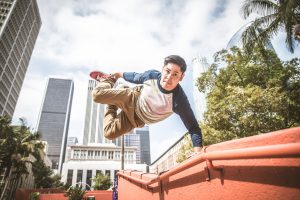Landscaping Selves Through Parkour: Reinterpreting the Urban Environment of Singapore
June 22, 2020


Parkour is a type of activity usually performed in an urban environment which incorporates multiple movements such as running, jumping, and swinging to negotiate from one point to another in the most efficient, quickest, and shortest way possible. Parkour Singapore hosted the Lion City Gathering IV on the 22nd to 24th June 2018. The Lion City Gathering holds workshops that introduce Singaporeans to a multitude of parkour-related activities. Even the elderly and young children can participate, with a Senior Citizens Parkour Workshop and Kids Parkour Workshop organized by MOVE Academy Singapore and Superfly Monkey Dragons respectively. Last year, the three day event rounded off memorably with the Asian Parkour Championships, held in Singapore for the first time.
Mr Wen Bin Loo and Professor Tim Bunnell (both from NUS Geography) co-authored ‘Landscaping Selves Through Parkour: Reinterpreting the Urban Environment of Singapore’ (Space and Culture, 2017), which explains how parkour reveals complex relationships between the self and the landscape. In Singapore, the built environment is well-maintained and sculpted both materially and metaphorically. This offers few alternatives for pedestrians to manoeuvre through the landscape and subjects them to commonplace practices and behaviour. On the other hand, parkour allows its practitioners to make sense of, and create alternative meanings from the urban environment. Parkour constitutes of an unorthodox way of moving through the environment that liberates its practitioners, enabling them to deviate from the norm. Additionally, the authors found parkour helps its practitioners broaden their perspectives when making sense of their identities. One of the practitioners pointed out that in both parkour and in real life, one had to be consistently aware of and be prepared for ever-changing surroundings and scenarios, and learn how to expertly navigate through them.
Read the article here.
